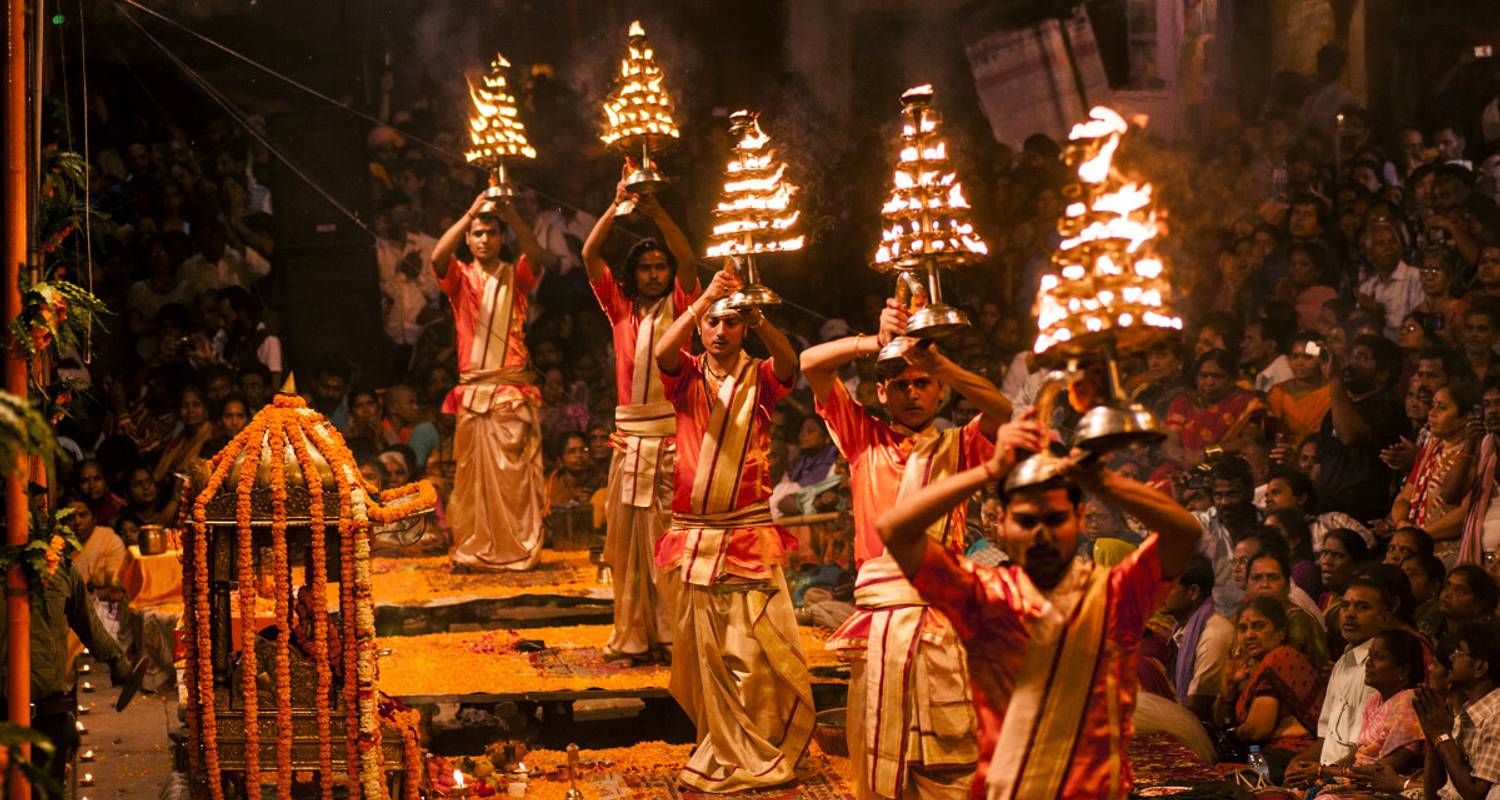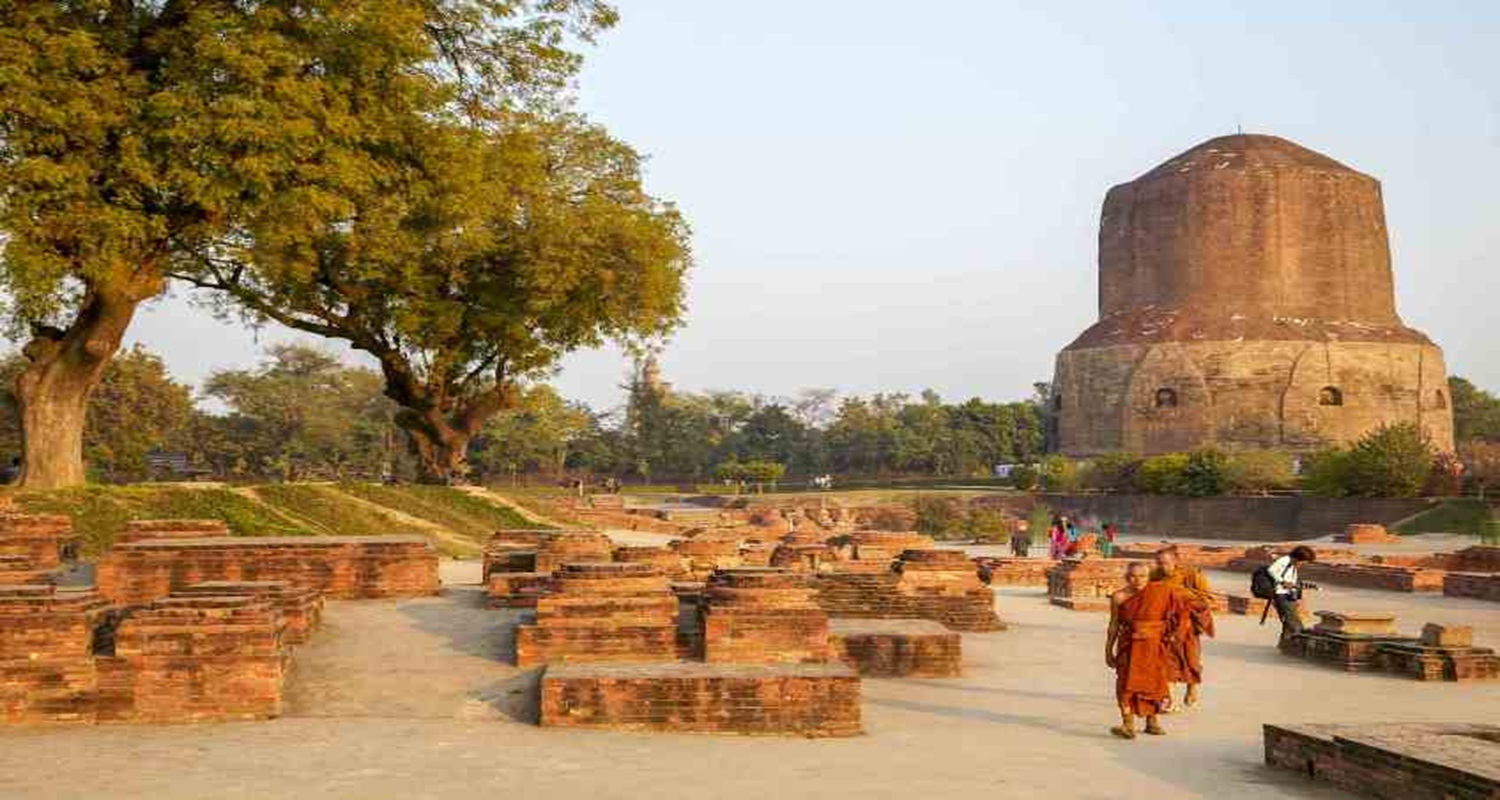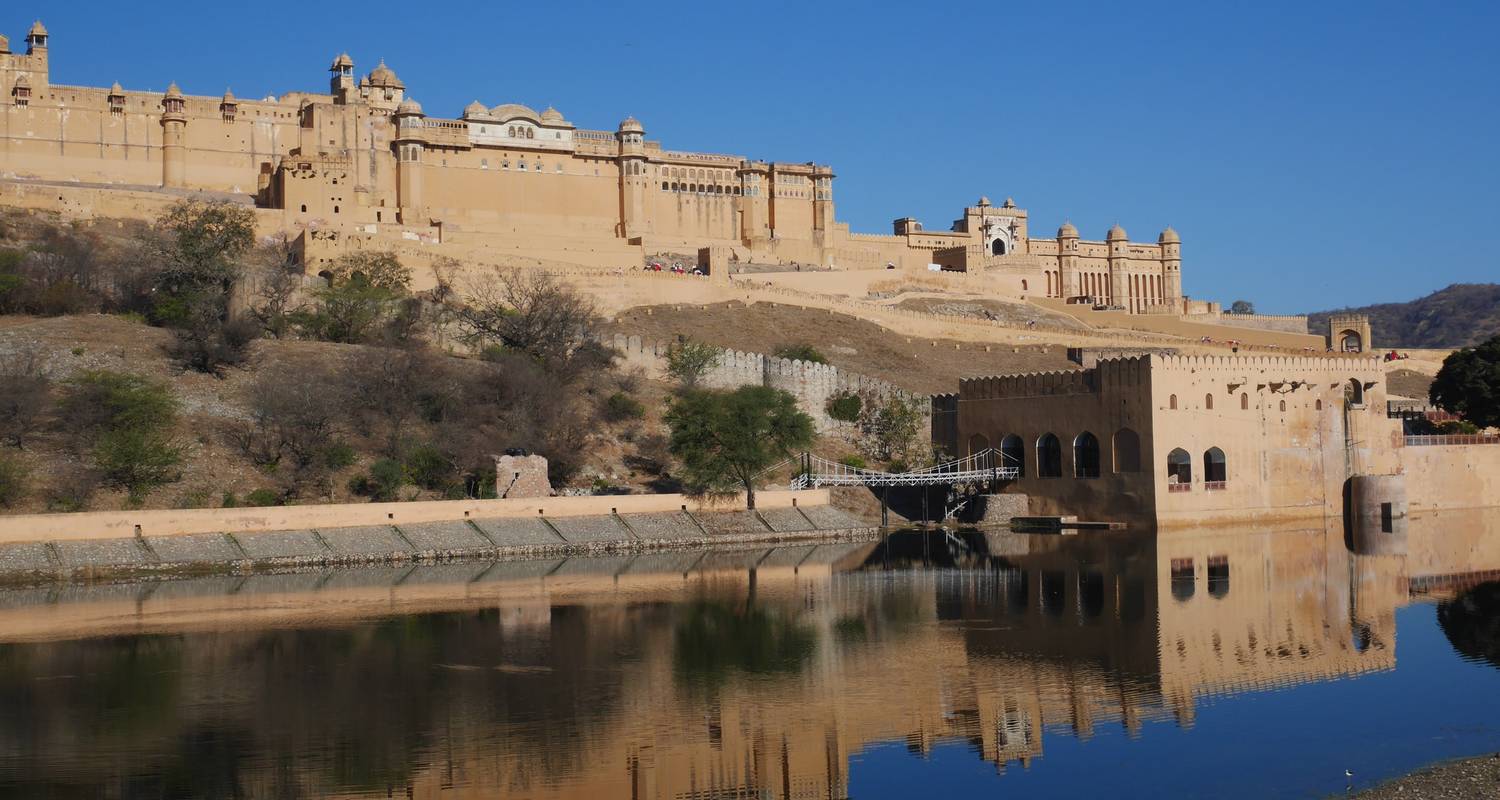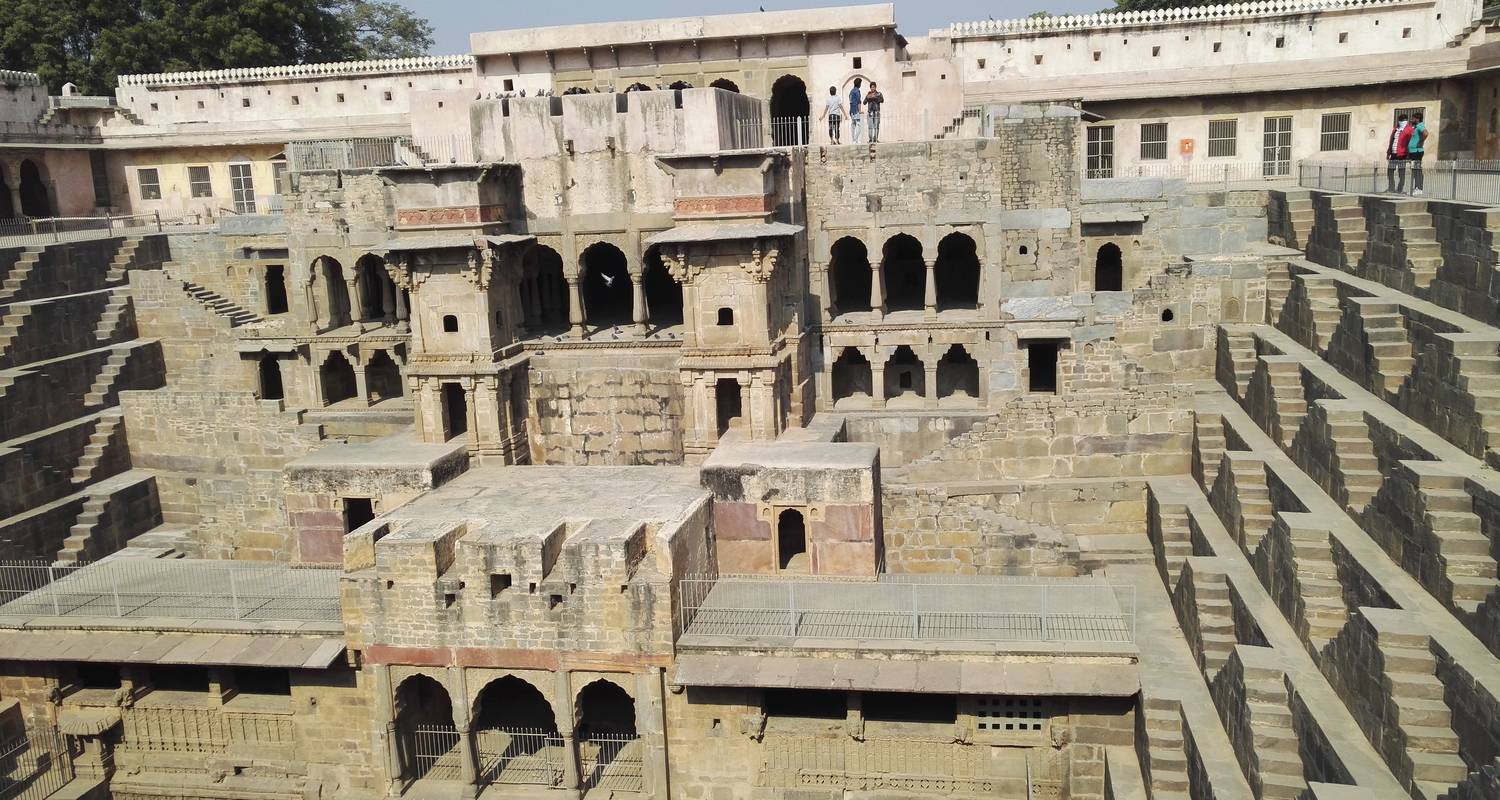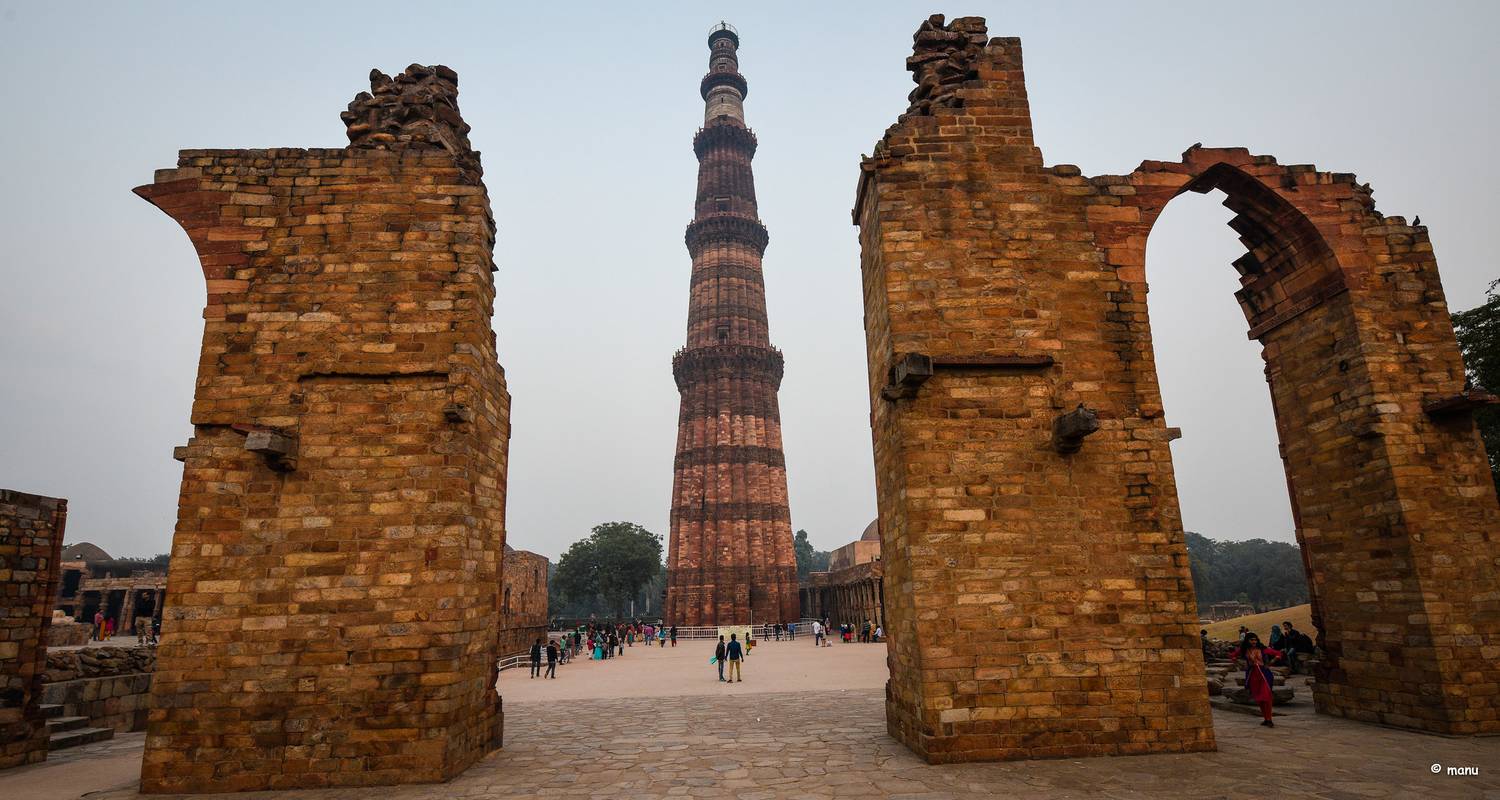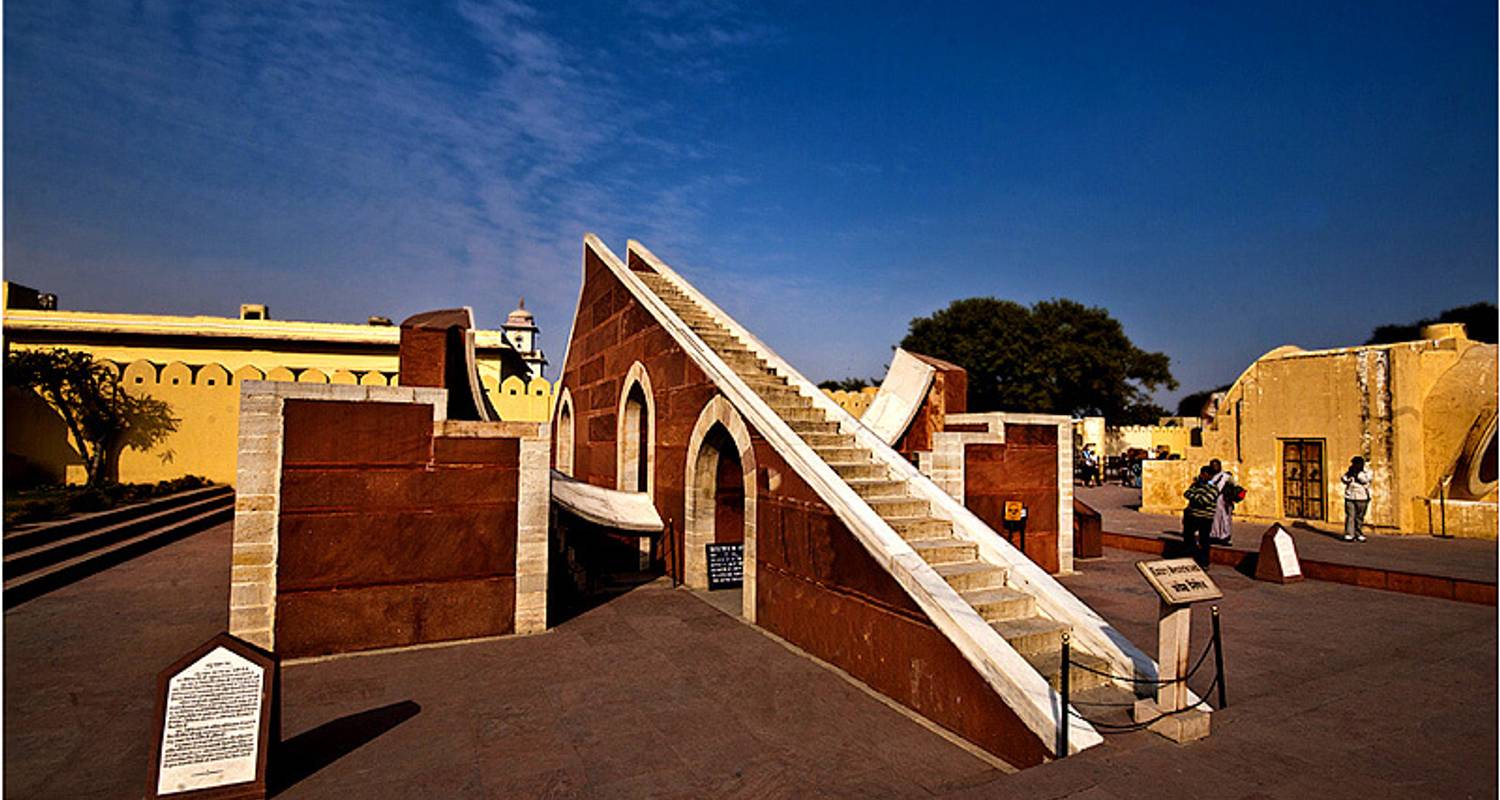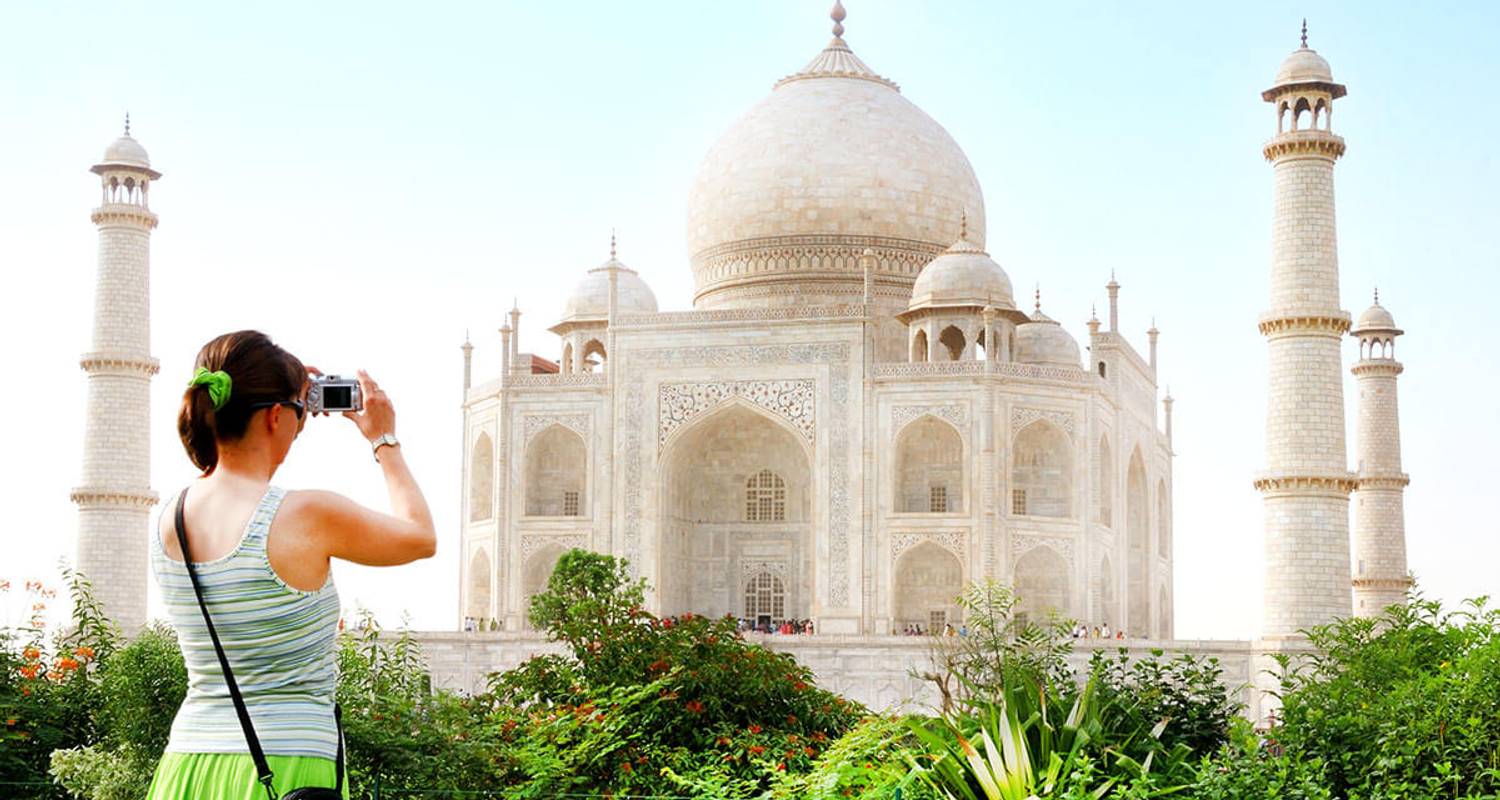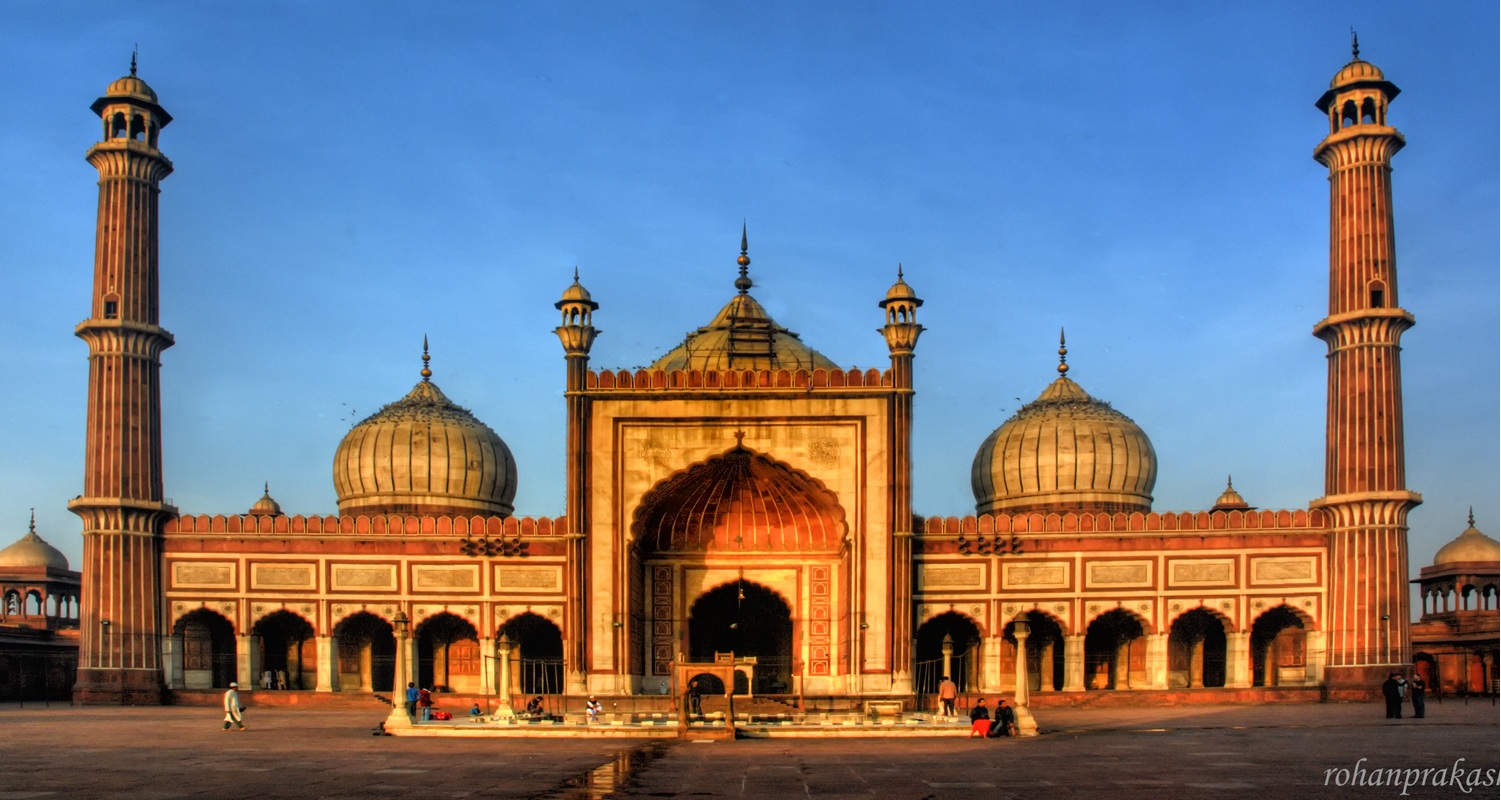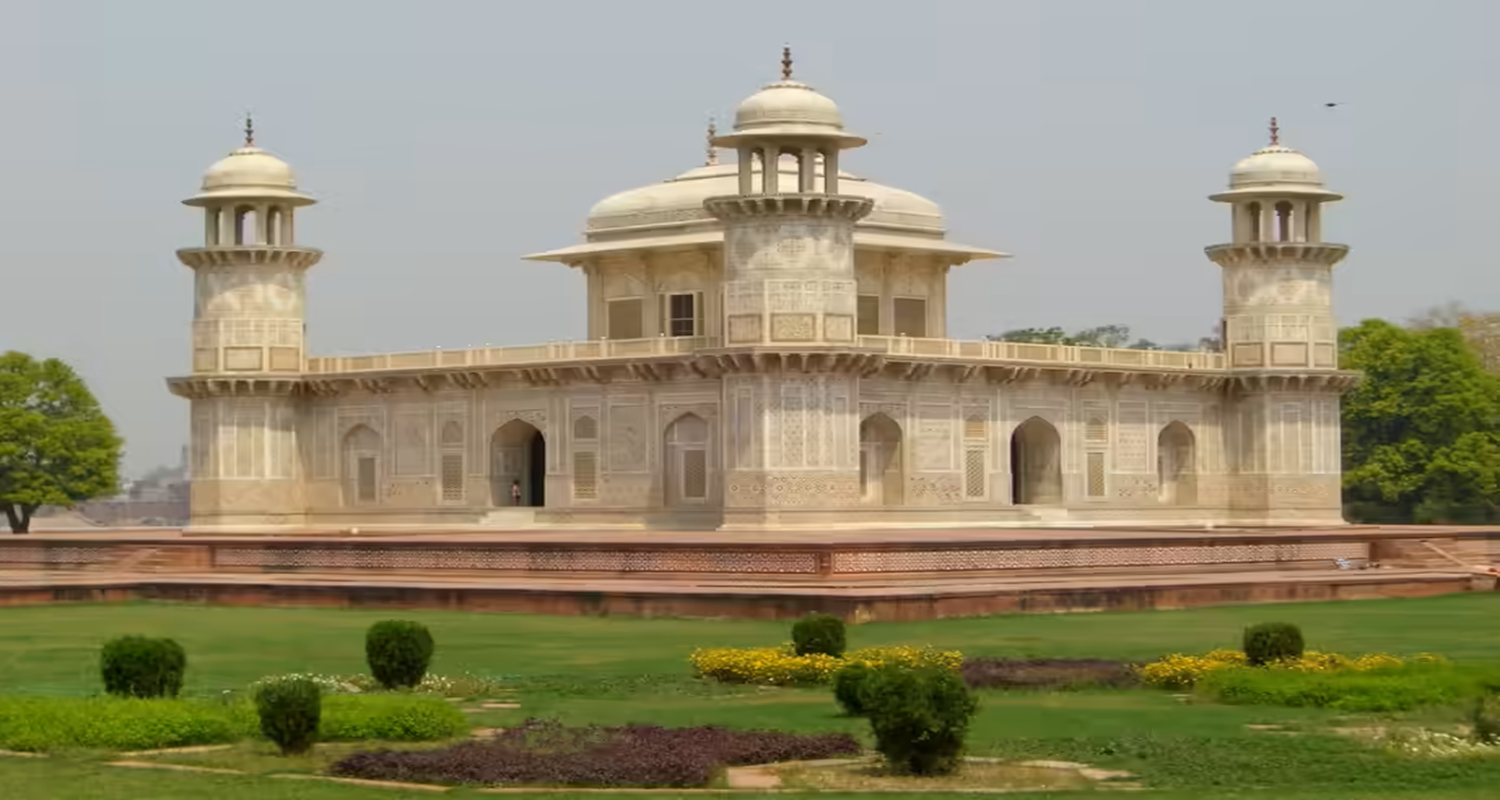
Rajasthan
Golden Triangle With Varanasi
NotIncluded
INR 65984 Per Person
3-4-5 stars
Travel Duration
7 Days / 6 Nights
Included in the trip
Individual departures
All Round The Year
Embark on a remarkable tour that blends India’s iconic Golden Triangle with the soul-stirring city of Varanasi — curated beautifully by My Tour Advisor. This journey takes you from the bustling heart of Delhi through the timeless marvels of Agra and Jaipur, culminating in the spiritual awakening of Varanasi, offering a seamless experience of culture, history and devotion.
Your adventure opens in Delhi, where old-city lanes meet imperial avenues. Explore Old Delhi’s Jama Masjid and the bustling bazaar of Chandni Chowk, then shift to New Delhi’s stately monuments and wide boulevards, experiencing the layers of India’s past and present. Move on to Agra, where the majestic Taj Mahal glows at sunrise, followed by exploration of the formidable Agra Fort. These sites offer compelling insights into Mughal elegance and architectural precision. In Jaipur, the “Pink City,” discover majestic royal palaces, hilltop forts and vibrant bazaars. Visit the Amber Fort with sweeping views, the ornate courtyards of City Palace, and wander through alleyways filled with textiles, handicrafts and local character. Finally, arrive in Varanasi, India’s spiritual epicentre. Glide on the Ganges at dawn, witness the mesmerising evening Ganga Aarti, and stroll the ancient ghats where faith is alive in every moment. Varanasi’s timeless rhythms make this a deeply moving end to your journey.
With My Tour Advisor in charge, expect private transport, hand-picked accommodation, expert local guides and thoughtful experiences. This isn’t just a tour of landmarks — it’s a transformative voyage into India’s heart. From the grandeur of monarchs to the serenity of sacred waters, the Golden Triangle with Varanasi delivers an unforgettable blend of heritage and spiritual depth.
Stages Of Tour
Day 1
ARRIVAL IN DELHI & SIGHT SEEING
Welcome to DELHI, The Capital of India. Your flight would land at Indira Gandhi International Airport. After landing kindly head towards the immigration department and get your passport stamped. Immigration Department would stamp the Visa on your Passport. After the Immigration and Custom check Kindly Take an Exit from the Airport from Exit Gate No 4. My Tour Advisor’s Representative would be waiting you for your welcome outside the Gate No 4. After the Meet Proceed towards the visit of the capital of India.
Delhi, India’s captivating capital, is not just a city, it’s a journey through time. From the legendary Indraprastha of the Mahabharata to the grandeur of the Mughals and the elegance of British colonial rule, Delhi has been the stage where history was written. Here, ancient bazaars buzz with spices and silks, while majestic monuments whisper tales of empires long gone. Yet, beyond its history, Delhi is alive with vibrant traditions, mouthwatering street food, colourful festivals, and a cosmopolitan spirit. It is a city where every corner offers a discovery—whether it’s a rickshaw ride through the chaotic lanes of
Chandni Chowk or a stroll past Lutyens’ stately avenues. For travellers, Delhi is not just a destination, but the perfect gateway to experience the soul of India.
Full Day Dedicated to the exploration of the city. The day would start from the visit of Chandani chowk and Jama Masjid, one of the largest and most impressive mosques in India. Built by Mughal Emperor Shah Jahan in the 17th century, this architectural marvel features grand red sandstone courtyards, intricate marble inlay, and towering minarets that offer panoramic views of the city. The mosque’s serene atmosphere provides a striking contrast to the bustling streets outside. From here, dive into the vibrant chaos of Chandni Chowk, Delhi’s oldest and busiest market. Enjoy a ride on cycle rickshaw passing centuries-old shops, taste famous street food and explore treasures ranging from spices and textiles to silver jewellery. Explore the famous spice market Khari Baowli - Asia’s largest spice market.
Afterwards drive through the Lutyens Delhi. designed by British architect Sir Edwin Lutyens, is the heart of India’s capital. It features wide boulevards, grand gardens, and iconic landmarks like President house, India Gate, and Parliament House.
End your day with the visit of Humayun’s Tomb, a UNESCO World Heritage Site, it is a splendid example of Mughal architecture and the first garden tomb in India. Built in the 16th century by Empress Bega Begum for Emperor Humayun, its grand red sandstone structure with white marble domes later inspired the design of the Taj Mahal. Surrounded by Charbagh-style gardens, intricate arches, and Persian-influenced details, the monument reflects the glory of the Mughal era. After the visit return to the hotel. Overnight stay in Delhi.
Day 2
DELHI – JAIPUR (260 KM – 5 HOURS)
After breakfast. Start your drive towards JAIPUR, also called as the pink city. It will take you 5 to 6 Hours to reach Jaipur. On arrival you would be taken to your hotel for check-in.
In the afternoon Visit the Famous Shrine of Galta Ji. It is a religious shrine located at the outskirts of the city in the middle of the Hills. It was the meditating place for the Rishi Galav. The shrine has a religious Pond which is feed by natural spring water. Devotees come to GALTA ji to take a holy dip in the pond and pay homage to the Rishi Galav. Now the Temple is more famous for the Monkeys who have found this place a natural habitat, hence the place has Acquired the name as Monkey Temple.
Afterwards Proceed towards Birla Temple. Built in white marble, Birla Mandir is located in the centre of the city and dedicated to Lord VISHNU and Goddess Laxmi. It is one of the important hindu temple of the Jaipur. After the Visit Return to the Hotel for your overnight Stay.
Day 3
JAIPUR SIGHTSEEING
Jaipur as a city came in to existence in the year 1727 when current Maharaja Jai Singh decided to build a new city to accommodate the rising population of the city. He envisioned a planned city, drawing on scientific and architectural principles of the time, making it one of India's first planned cities. The city's layout, based on Vastu Shastra and Shilpa Shastra, features a grid-iron plan with nine sectors. Jaipur's historical walled city was completed within four years, showcasing a blend of ancient and contemporary architectural styles.
After breakfast, drive towards Amber Fort with a photo stop at Hawa mahal (wind Palace). The fort is perched atop a hill. You can choose to reach up to the top of the hill on an elephant (on direct payment) or in jeep. The fort is famous for its stunning red sandstone and marble structures which includes various courtyards, buildings and pavilions. The most famous structures are Ganesh Pol – the Main entrance gate. The Sheesh Mahal (Mirror Palace) and royal chambers.
After the visit take a photo stop at Jal mahal – the lake Palace of Jaipur
After wards Visit the City Palace Jaipur, located in the heart of the Pink City, the complex includes courtyards, gardens, and several buildings. Its museum has a vast collection of royal costumes, artifacts, textiles & antique furniture.
Later proceed to visit the Jantar Mantar Observatory, it's one of the most well-preserved and largest astronomical observatories in the world. It includes sophisticated tools for the calculation of eclipses and for the detection of the position of stars, the calculation of ascendants. The principal attraction of the building is 27-meter-high sundial which is located in the center of the observatory.
After the visit explore the old city and its vibrant market. After the foundation of the city Jaipur attracted skilled artisans, craftsmen, and merchants from various parts of India to settle here. This led to a flourishing arts and crafts industry, with skilled craftsmen specializing in gem cutting, jewellery making, block printing, Textiles, and miniature paintings. Today Jaipur has become a paradise for shoppers.
later return to the hotel for dinner. Overnight stay in Jaipur.
Day 4
JAIPUR – ABHANERI - FATEHPUR SIKRI – AGRA (230 KM – 5 Hrs Approx)
After a sumptuous breakfast, Start your drive towards Agra, Along the way take a stop at Abhaneri Step Well - Also called as Chand Baori, It is one of the most remarkable stepwells in India and a fine example of ancient engineering and architecture. Built in the 9th century by King Chand of the Nikumbh dynasty, this massive structure was designed to conserve water in the arid desert climate. The stepwell descends about 20 meters and features over 3,500 narrow steps arranged in a symmetrical, crisscross pattern across 13 levels, creating a striking geometric design. Its clever construction ensured that the water remained cool, making it a vital source for drinking, irrigation, and community needs.
After the Visit Proceed towards Fatehpur Sikri, located about 40 kilometers west of Agra, It is a UNESCO World Heritage Site and one of the finest examples of Mughal architecture in India. Built in the late 16th century by Emperor Akbar the Great, it served as the capital of the Mughal Empire for a brief period from 1571 to 1585. Akbar constructed this magnificent city to honor the Sufi saint Sheikh Salim Chishti, who had blessed him with the prophecy of a male heir. The city is a blend of Islamic, Hindu, and Persian architectural styles, showcasing Akbar’s vision of a unified empire.
After the visit proceed towards Agra, On arrival in agra transfer to the Hotel for check-in. Overnight stay in Agra.
Day 5
AGRA SIGHTSEEING
Agra is a city steeped in history, heritage, and architectural splendor. Best known as the home of the Taj Mahal, one of the Seven Wonders of the World, Agra draws millions of visitors from across the globe. Once the capital of the Mughal Empire, the city showcases stunning examples of Mughal architecture, including the majestic Agra Fort and Baby Taj. Beyond its monuments, Agra offers a rich cultural experience with bustling markets, traditional crafts like marble inlay work, and flavorful Mughlai cuisine. Agra is not just a destination—it is an unforgettable journey through time, beauty, and imperial legacy.
After Breakfast proceed towards the visit of Tajmahal- built by Emperor Shahjahan for his beloved wife Mumtaz Mahal. Taj Mahal is not just a monument—it's a timeless poem in white marble, a symbol of undying love etched into history. Skilled craftsmen from Persia, Turkey, France and Italy and some 20,000 laborers worked for 17 years to build this edifice. Marble was brought from Makrana near Jodhpur and precious stones of onyx, amethyst, malachite, lapis lazuli, turquoise, jade, crystal and mother of pearl were carried from Persia, Russia, Afghanistan, Tibet and China. It is, truly, love immortalized in stone. After the visit return to the hotel for breakfast
Later proceed towards the Agra Fort. It is a majestic red sandstone fortress located on the banks of the Yamuna River in Agra. Built primarily by Emperor Akbar in the 16th century and later expanded by his successors, the fort served as the main residence of the Mughal emperors. Enclosed within massive walls are a series of elegant palaces, audience halls, and mosques, including the Jahangiri Mahal, Diwan-i-Khas, and Moti Masjid. A fine example of Mughal architecture, blending Islamic and Hindu elements, Agra Fort offers a glimpse into royal life and India's rich historical legacy.
End your day with a visit to Mehtab Bagh, meaning “Moonlight Garden,” It is a Charbagh-style garden complex located across the Yamuna River, directly opposite the Taj Mahal. Built by Emperor Babur in the 16th century, it was later restored by Shah Jahan to serve as the perfect viewing point for the Taj. The beautifully aligned garden offers a serene atmosphere, with fountains, pavilions, and walkways designed to frame the monument’s reflection in the river. Best visited at sunset, Mehtab Bagh provides a breathtaking perspective of the Taj Mahal away from the crowds, making it a photographer’s paradise and a peaceful retreat.
After the visit Return to the Hotel. Overnight Stay in Agra.
Day 6
AGRA – VARANASI (Train | 7 Hours)
Varanasi, also known as Kashi or Banaras, is one of the oldest continuously inhabited cities in the world and a major spiritual hub in India. Located on the banks of the Ganga River in Uttar Pradesh, it is considered the spiritual capital of India. The city is sacred to Hindus, Buddhists, and Jains, and is famous for its ghats, ancient temples, and ceremonial aartis. People come here to seek moksha (liberation), perform last rites, or simply experience its timeless mysticism. With its rich blend of faith, culture, music, and learning, Varanasi leaves a lasting impact on every visitor.
Early morning transfer to railway station to catch the train for varanasi. Breakfast on board. The train departs at 6 am in the morning. After a 7 hours Journey you would arrive at Varanasi railway Station.
On Arrival meet with My Tour Advisor’s Representative and transfer to your hotel.
In the afternoon head out to visit the Buddhist complex of Sarnath. Take your Lunch at a local traditional Indian restaurant. Afterwards visit the Sarnath Buddhist complex. It is one of Buddhism’s most sacred sites. It is where Lord Buddha gave his first sermon after attaining enlightenment, known as the Dharmachakra Parivartan (Turning of the Wheel of Dharma). The site features important monuments like the Dhamek Stupa, Chau Khandi Stupa, and the Ashokan Pillar with its lion capital, India’s national emblem. Sarnath also houses a rich archaeological museum showcasing ancient artifacts and sculptures. Peaceful and spiritually significant, Sarnath attracts pilgrims and history enthusiasts from around the world, offering a deep insight into the early teachings and spread of Buddhism.
In the late Afternoon head out towards Namo ghat to catch the boat to attend the ceremonial evening Aarti (Prayer) to Mother Ganges. Ganga Aarti is a captivating spiritual ritual held every evening at Dashashwamedh Ghat. As dusk falls, priests dressed in traditional attire perform the aarti with large brass lamps, synchronized chants, conch sounds, and incense, all offered to Mother Ganga. The atmosphere
becomes divine, with glowing lamps, rhythmic mantras, and the river reflecting the golden light. Devotees and tourists gather on the Ghats and in boats to witness this mesmerizing ceremony. it symbolizes gratitude to the sacred river and invokes divine blessings. The Ganga Aarti is not just a ritual—it’s a
soulful experience that touches every heart.
After attending the Prayer return to the hotel. Overnight Stay in Varanasi.
Day 7
VARANASI - DELHI (FLIGHT | 1.5 Hours)
Wake up before dawn and head towards the Ghats to Experience the morning Boat ride on Ganges. Its a spiritually moving experience. As the first light of dawn touches the waters of the Ganga, the ghats come alive with a unique blend of devotion, ritual, and everyday life. From the boat, you witness priests performing aarti, devotees taking holy dips, yogis meditating, and locals beginning their day. The calm of the river, the golden sunlight, and the chants echoing from the ghats create a magical, almost timeless atmosphere.
Afterwards visit the Kashi Vishwanath Temple and take a walk into the Narrow Alleys of the Old City.
After the visit return to the Hotel, In the Afternoon Transfer to Varanasi Airport to catch the flight for Delhi. On arrival at delhi airport, Transfer to International Terminal to Catch the flight for your onward Destination.
The hotels
My Tour Advisor Provides a wide variety of hotels
Cost Per Person For Different Categories
| # | No of Pax | Standard | Superior | Prestige |
|---|---|---|---|---|
| 1 | 2 Pax | INR 65984 | INR 77891 | INR 92775 |
| 2 | 4 Pax | INR 59386 | INR 69999 | INR 82999 |
| 3 | 6 Pax | INR 55999 | INR 66200 | INR 78800 |
| 4 | 8 Pax | INR 52700 | INR 61999 | INR 73999 |
| 5 | 10 Pax | INR 49488 | INR 58418 | INR 69581 |
Supplements
| # | Plan | Standard | Superior | Prestige |
|---|---|---|---|---|
| 1 | Single Supplement | INR 39590 | INR 47734 | INR 55565 |
| 2 | Half Board | INR 2400 | INR 4800 | INR 9600 |
| 3 | Full Board | INR 4800 | INR 9600 | INR 19200 |
| 4 | Christmas Supplement | INR 16496 | INR 19472 | INR 23193 |
| # | Months | Dates 1 | Dates 2 |
|---|
Inclusions
- Accommodation as per Itinerary on twin sharing with Bed and Breakfast Plan.
- All Transport & Sightseeing by private Air conditioned vehicle as per program.
- Local Professional Spanish-Speaking Guide for Sightseeing
- Monument Entrance fees.
- Domestic flight from Varanasi to Delhi in Economy class (check-in baggage limit – 15 Kg.)
- Rickshaw Ride in Old Delhi
- Visit of Abhaneri Step well - An 8th Century Architetural Marvel
- 2 bottles of water per traveler per day
- Travel kit document bag
- One souvenir gift from MY TOUR ADVISOR
- Private and personalized services.
- All taxes, fees and handling charges
- GST (Goods and Services Tax)
Exclusions
- International Flights
- Visa and Insurances
- Food and drinks, unless specified.
- Gratuities (recommended).
- Anything not mentioned and specified in Itinerary and in inclusions.
TOUR HIGHLIGHTS
- All Inclusive Tour. – Hotels / Transport / Guides
- Rickshaw Ride Through the Narrow Lanes of Chandni Chowk Market at Delhi.
- Visit of Tajmahal - The Monument of Love
- Visit of Abhaneri Step well - An 8th Century Architetural Marvel
- Visit of Gaitor ki Chatri - a jewel out of touristic places at Jaipur
- Galta monkey temple
- Boat ride at Varanasi
Enquiry Form
Please fill the below form for more information
PASSPORT
A valid passport is required for at least six months before Boarding the Flight. We encourage you to check the validity of the passport and we advise you to bring a photocopy of your passport and the page of the visa obtained, or carry multiple copies of ETA, useful in case of loss.
INDIAN CONSULAR VISA
To enter India, an entry visa issued by the Indian Embassy is required. It is categorically necessary that all travellers, whose itinerary includes leaving and returning to the country, have obtained a double or multiple visas. During the flight to India you will be given a disembarkation form to be filled in with your data and to be delivered to passport control. The detachable part completed with the customs declaration will be returned to you, and must then be handed over to the customs upon leaving the airport.
INTERNAL FLIGHTS
Air tickets for flights within India or between India and Nepal, if not included in the intercontinental flight, will be collected by your companion or our representative and will be delivered to you upon arrival. Flights within India and between Nepal are the trickiest part of the journey. We recommend a lot of patience, because it is not uncommon for flights to suffer delays, cancellations or make intermediate stops not foreseen at the time of booking. It is therefore essential to always go to the airport on time (about 2 hours before the flight). In the event of cancellations, however, the companies, according to the new regulations, will refund the cost of the ticket but have no obligation to re-route. The rebooking will then be done by our local office by purchasing a new ticket. Purchasing it on the same day, the same fare as the canceled flight is not always available. In case this exceeds that of the cancelled flight, the difference must be paid directly on the spot. If there are no other flights on the scheduled route, a land transfer by car/bus will be provided in lieu of the ticket.
DOMESTIC FLIGHTS BAGGAGE ALLOWANCE
Since recently (August 2013) both on intercontinental flights and on internal flights, the companies are very strict in calculating the weight of the baggage and each additional kilogram is subjected to an extra payment according to the rules of the company itself. In this regard, we report the scheme concerning the baggage allowance for the economy class granted by each airline for flights within India and between India and Nepal:
Airline
Hand Baggage Weight
Checkin Luggage Weight
Air India
7 kg + Laptop
15 kg
Jet Airways
7 kg + Laptop
15 kg
Indigo & Spice Jet
7 kg + Laptop
15 kg
Go Air
7 kg + Laptop
15 kg
Jet Lite
7 kg + Laptop
15 kg
The company has the right to apply an extra cost for each kilogram exceeding the above, (indicatively from 4 to 8-euro per kg).
LOCAL GUIDES AND ESCORT TOURS
For the entire duration of the group tour, starting from your arrival in India, you will be assisted by a Tour Escort or local Guide (for individual tourists) in each city who will take care of every technical-organizational detail. The tour escort will also act as a local guide in the cities for which he is licensed. In the others he will be accompanied by a local foreign speaking guide or English-speaking guide as per the provisions of the Indian government. In the latter case, he will provide for the translation.
In many cities of India, in fact, there are no local guides speaking foreign languages (especially in southern India, central India and some parts of Rajasthan), or there are few.
THEFT
We remind you that passport, telephone and valuable accessories in general must always be kept by the passenger and never left unattended, as no service facility takes charge of any loss/theft during the tour. It is also good to have all the emergency bank numbers with you in case of need.
TIPS
In India, tipping is a custom rooted in local custom. The amount of tips is at the discretion of the passengers, but as a rule they are in the local custom. In restaurants it is customary to leave 10% of the bill as a tip.
A basic tip:
For half day drive with driver Rs. 300/ full day Rs. 500.
For porters Rs. 70 per bag
For Half Day Local Guide Rs. 500/ Full Day Rs. 800
Per Day Escorts Rs. 1000
(The amount is in total and refers to a group of 2/3 people, it can be increased if you are traveling in a group with more people)
For groups, even small in number but with tour escorts, it is advisable to give the guide a sum at the beginning of the tour (approximately 40/45 euros for 7/9 day tours) and he will distribute them appropriately, thus avoiding boring and continuous collections.
N.B. (This figure does not include a possible tip for the companion)
ROOM AVAILABILITY
The rooms are available until 12.00 on the day of departure. In India there is no day use system, therefore if the rooms want to be kept until departure they will have to be paid for the entire following night.
CHECK-IN ONLINE
We inform you that the check-in procedure can take place via online check-in, which can be implemented from the airlines' websites or via the automatic check-in devices specifically installed at the airport.
CLIMATE
The most pleasant season runs from mid-November to March, with moderate heat and low rainfall. The maximum temperatures vary from 27° to 30°, the minimums from 16° to 22°. In March the temperatures begin to rise with highs reaching 38°. The month of August records the peak of the monsoon season (from June to October) which invests the south-western regions with rainfall that varies in intensity according to the areas, limited in some to severe thunderstorms. In October and in the first half of November the south-eastern part of India is affected by a north-east monsoon.
CLOTHING
Clothing must take into account the period and the regions where you go. In southern India, light clothing can be worn all year round, without forgetting long trousers and long-sleeved shirts to protect against insects. During visits to the temples, excessively small clothing should be avoided. For those traveling to the northern regions, warmer clothing is needed, as the temperature can approach freezing in winter. In the desert region of Rajasthan the temperature varies a lot between day and night.
SHOPPING
In India the variety of handicraft production is practically infinite. Indian muslins, canvases, silks and brocades have enjoyed worldwide fame since ancient times and have been appreciated for the quality of the fabric, the beauty and resistance of the colors, the originality of the designs. Even today the brightly colored silk saris, embroidered or woven with gold or silver threads, the brocades of Varanasi as well as the cottons of Rajasthan, the wool or wool and silk carpets of Kashmir and Uttar Pradesh are renowned. The manufacture of fabrics is just one aspect of the varied and rich Indian craftsmanship which ranges from wood carving (teak, sandalwood, rosewood, ebony) spread almost everywhere, especially in Karnataka, to Agra marble inlays or the stone sculptures of Orissa, from ceramics to hand-painted lacquers, from brass and copper pottery to bamboo and leather objects. The skill of the Indians in the cutting and processing of semi-precious and precious stones has been known since ancient times. Haggling in the bazaars is common practice.
Do not buy souvenirs that cost animals their lives or harm nature.
FOOD AND DRINK
It is recommended to drink only bottled or boiled water (found in almost all restaurants and hotels). Carefully avoid tap water and ice in drinks. It is advisable to consume only well-cooked foods and packaged foods, avoiding raw vegetables and fruit that cannot be peeled.
MEDICAL ASSISTANCE
In India there is a great variety of doctors practicing the most diverse forms of therapy and the only hospital in Europe is located in Delhi. It is advisable to bring from Italy tablets against any gastrointestinal disorders and medicines that are difficult to find locally.
BEHAVIOUR
Before entering the temples, mosques and or gurdwaras it is essential to take off your shoes, generally it is allowed to keep your socks on. To avoid discomfort, do not bring leather articles of any kind with you, because they could arouse some opposition. Inside places of worship, tourists can move as they please and sometimes attend religious rites, for which it is preferable to wear modest clothes, avoiding tops, skirts and shorts. A small donation will be welcome.
The folded hands namaste is the typical Indian greeting and its use will be greatly appreciated. Especially in cities, men will gladly shake hands with tourists; in fact, this gesture is considered particularly cordial. The majority of Indian women, on the other hand, are reluctant to shake hands with a man, both Indian and foreign (a possible refusal should not be considered an offense) and are generally surprised by the informality of relations between the two sexes used in western countries. In private homes you will be welcomed as guests of honor and your lack of familiarity with local customs and traditions will be understood and accepted. If you should be tempted to eat with your fingers, remember to use only your right hand.
GASTRONOMY
Indian cuisine varies according to the regions, with notable differences between the southern and northern regions, but has as a common feature the wise use of spices which are used not only to flavor foods but also to aid digestion. In the north it looks remarkably like that of Middle Eastern or Central Asian countries; there is great use of chili (hot pepper), the staple food is wheat, and various types of unleavened bread are consumed, such as pooris or chappatis. The meats are quite common, naturally not beef. In the south, where the Muslim influence has been less strong, vegetarian diets prevail, and the cuisine revolves around rice, consumed in an infinite variety of ways. The highly savory taste of Indian foods is related to the blend of spices frequently used in food preparation. These mixtures (kari) can accompany various vegetables, chicken or lamb meat, fish or rice. Rogan josh (lamb curry), gishtaba (spiced meatballs with yoghurt), korna (vegetable meat-based stews) are very common in the north. In the south, various vegetable dishes are widespread, including bhujia (a vegetable curry) and along the coasts, fish dishes, the Cochin prawns are delicious. Perhaps the most common dishes throughout India are, however, the simple dhal, essentially a lentil soup, and the thali, the typical vegetarian dish, usually served on a tray with small bowls full of vegetables accompanied by large -of quantity of rice. Among the desserts, kulfi, the typical pistachio ice cream, is very common, while tropical fruit is very abundant. It is a frequent habit to conclude the meal by chewing pal, a mixture of spices, betel nuts and other powders, all wrapped up in an edible leaf. Tea is the most popular drink and some varieties of Indian tea are famous all over the world. Try the rice beer.
LANGUAGE
In India a large number of local languages are spoken, very different from region to region, among which Hindi is the official one. English represents a strong instrument of national cohesion and is very widespread, especially in hotels or in places frequented by Westerners.
RELIGION
Religion forms an integral part of India's complex tradition. Four of the most important faiths in the world meet on this territory: Hinduism, Buddhism, Christianity and Islam and among these the first two were born in India. furthermore, this country which welcomed the Jews and the Parsees (followers of Zoroaster), who then integrated into Indian life, gave rise to Jainism, Sikhism and other innumerable cults and regional sects of lesser importance and which for centuries have acted and interacted with each other.
AIRPORT FEES
They usually already include exit taxes from the country. However, we recommend checking at the airport, as these are subject to change regulations.
PHONE
The cellular network is active in the country, however Italian cell phones are only active in the main cities and it is therefore advisable to purchase a card locally. To call from India the area code is 0039. To call India dial 0091.
VACCINATIONS
No mandatory vaccination is required for travelers from Italy. Before travelling, it is advisable to consult the competent ASL on the need to carry out vaccinations or appropriate prophylaxis. In general, subject to medical opinion, vaccinations against: diphtheria, hepatitis A and B, typhoid, tuberculosis, polio and tetanus booster are recommended. However, we recommend checking the Viaggiare Sicuri website at the link http://www.viaggiaresicuri.it/index.php?india
CURRENCY
The legal tender in India is the Indian Rupee. It is advisable to have currency in US dollars especially for entrances, Euros are also welcome. No Indian currency can be brought into the country or exported, while any amount of foreign currency can be imported. It is very complicated to exchange the Rupee in another currency, so it is advisable to buy in such quantities as to no longer have liquids in local currency at the time of departure. Credit cards, preferably from the VISA circuit, are accepted both in authorized shops and in hotels in large cities, where automated bank branches can also be used.
Our Staff
Our guides and
professional escorts have experience in the area and in-depth cultural
preparation. We can provide Guides in differenr languages also in most of the
sectors but in some areas there shall be only english speaking Guides
available, Such as Ladakh and the Himalayan areas, Kindly do check it with our
travel experts regarding the availabiluty.
Means of transport
Our organization
boasts a large fleet of new generation air-conditioned means of transport: from
standard or deluxe cars (2/3 pax) to Overland vehicles (2/3 pax); from
minibuses (4/8 pax) to grand tour buses (10/40 pax), with professional English
speaking drivers, always attentive to the needs of travelers. The roads that
connect the main cities of India are generally good. Indian Traffic conditions
limit the transfer times to an average of 50 km per hour.
Hotels and tented camps
In Indian
Subcontinent, the official category of hotels does not guarantee international
standards and does not always correspond to the expectations of the traveler.
The structures that MTA chooses, from luxury hotels, to Heritage Hotels (former
residences of the Maharajas), to lower category hotels, are periodically
supervised by our staff. In the Himalayan areas of Ladakh, hotels are provided
among the best existing and standard tented camps with limited comfort, where a
good spirit of adaptation is required.
Flights
The Major airports
where International flights Land are Delhi, Mumbai, Chennai, Kolkata,
Bangalore, Hyderabad, Almost all of the major International Airliens have
theor scheduled flights from these cities. including Swiss, Emirates, Qatar
Airways, Turkish Airlines, BrusselsAirlines and Etihad.
Personalized trips
Our Product
Managers are available to travelers to develop personalized itineraries (for
individuals or groups) and offer ad hoc programming, designed with maximum
flexibility and with smallest details, for those who want to immerse themselves
in the magic and spirituality of " Land of the Gods” outside the classic
Itineraries or with programs already present in the catalog. MTA is also
available to develop personalized travels in cinema, nature, sports, honeymoons,
incentive travel, business tourism and medical tourism in India.
India Visa
To obtain an entry
visa to India it is essential to have a passport valid for 6 months from the
date of travel (with at least three consecutive free pages), and two passport
photos. you can apply for ETA (Electronic Travel Authorization) The Link of the
website is https://indianvisaonline.gov.in/evisa/tvoa
Kindly check for permission Granted on ETA before boarding your flight.
